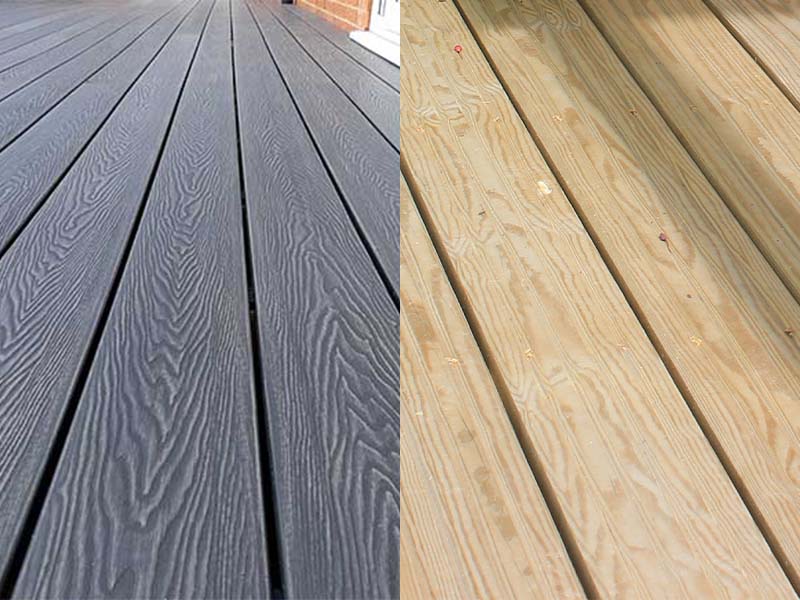13/05/2022 12:00 AM
What is more sustainable, composite vs wood decking?
Sustainability has become a key driving force in our decision-making process when it comes to buying a vast number of products.
Many of us weigh up a number of factors each time we purchase, including cost, quality, current trends, and more recently, the impact a product has on the planet. There are various material options when it comes to fencing and decking, including timber, composite, recycled plastic, and concrete. In this blog post, we answer a common question within our industry - ‘which is more sustainable, wood or composite decking?’.

How sustainable is wood decking?
Timber decking is made from wood which is a renewable resource. Renewable resources are defined as substances that can be replaced or replenished in less time than it takes to draw the supply down. Timber that is sourced from well managed forests is much more sustainable than man made materials which can’t be naturally grown.
If you do select timber decking, you should consider how long it will last. If you buy decking that has a short or no guarantee, it will have a higher carbon footprint because it’s not made to last a long time and will need to be replaced sooner. You will have to keep removing old decking, disposing of it, and buying new decking, therefore replacing it frequently, which is not only expensive and time-consuming but will also not provide a sufficient amount of time for new trees to grow. Our timber decking is guaranteed for 25 years and has been proven to last beyond that time; this means it has a close to zero carbon footprint as by the time it reaches the end of its life, a new tree will have grown.

It’s common that other manufacturers do not offer a treatment process that provides sufficient longevity and will advise you to continually retreat and re-stain the decking. Timber decking that has been through a good pressure treatment process should not need to be retreated again in its life, and should merely be cleaned to remove moss and lichen to keep it safe.
Is timber decking environmentally friendly?
In some ways timber decking is not environmentally friendly because it cannot be recycled, as the preservative used to prolong its life prevents it from being able to be broken down and recycled. Therefore, it will end up in landfill, but this is no different from its composite counterparts which will end up in the same place around the same life span as properly treated timber decking.
Staining and painting decking and ecological consideration
Jacksons’ timber decking does not need staining or painting to increase its longevity and will last 25 years and more. If you choose a timber deck that does not offer a reasonable guarantee it may need to be painted or stained to help the product last longer and reduce the decaying power of the elements. This will have a significant impact on how environmentally friendly the decking is.
Paints and stains contain unpleasant ingredients that have been found to be toxic to humans, plants, and animals. Painting and staining timber can have a detrimental impact on animals and insects in the garden which can be disturbed by the poisonous substances in the substances used. Unfortunately, once painted, a deck will have to be painted every few years to continue looking good. Disposing of hazardous waste (left-over paint or stain) and the containers that it is transported in both have an impact on landfill and the environment, as does the process involved in manufacturing the paint or stain.
How sustainable is composite decking?
Certain types of composite decking can contain up to 95% recyclable material, mainly from plastic and wood fibres. Composite decking manufacturers keep tonnes of wood and plastic from landfill sites.
The average composite decking will last for 25 - 30 years. Due to how it is made, the product cannot then be recycled so will end up in landfill at the end of its life. Composite decking, similar to our timber decking does not need to be re stained so no harsh or toxic chemicals have to be added throughout its life.
How is composite decking not sustainable?
An important consideration to take into account that is often not discussed is the process of turning the recyclable material into a decking board. The intensive process involved in creating composite decking takes a lot of energy, therefore increasing its impact on the environment.
Both types of decking should always be installed by a highly skilled professional to ensure the product is installed correctly. A poorly installed deck could impact the integrity and the lifespan of the product causing the need to replace parts or the whole deck early than needed. Replacing the decking will increase the carbon footprint and mean it is less sustainable.
In comparison, both materials offer a sustainable decking solution if the correct product is chosen and if the installation is correct. With timber you should always opt for a product which has a long guarantee and has been treated correctly to preserve its life, and it will equally match a composite deck in sustainability creed.

Is composite fencing safe?
Some composite products have been the cause of fires spreading rapidly, generating tall flames and high levels of heat release as well as producing high volumes of acrid smoke. If composite decking is a product that will be installed, always check with the composite manufacturer that products have been fire tested and have a declared flame speed rating.
Read more about the risks here